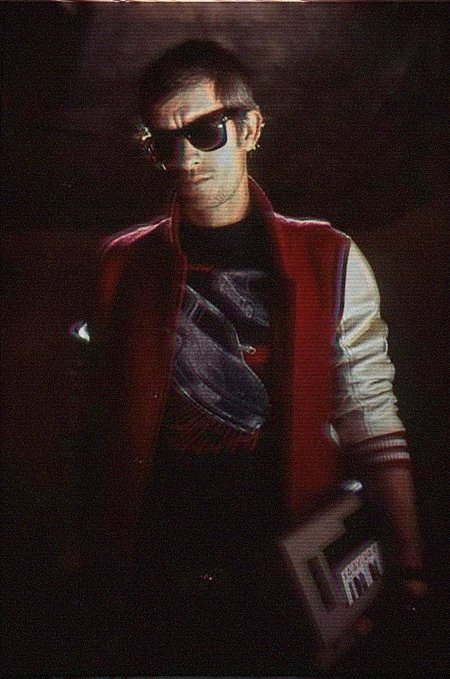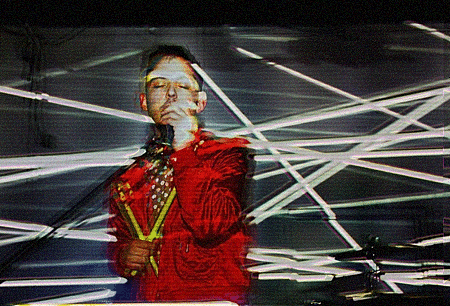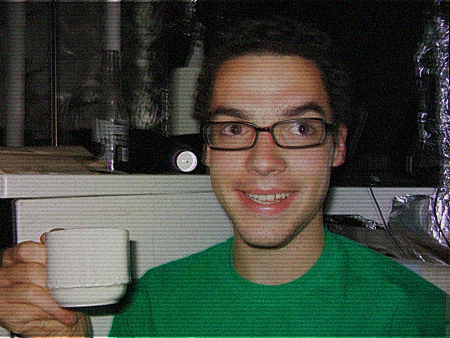
A while ago I found this killer tutorial for apply a VHS look to an image. I was able to whip up a little matlab filter to do it procedurally. Here's the vhs function:
function V = vhs(im,varargin)
% VHS Apply a VHS filter to an image
%
% V = vhs(im)
% V = vhs(im,'ParameterName',ParameterValue,...)
%
% Inputs:
% im h by w by c image
% Optional:
% 'VerticalLoop' followed by whether to loop the bent strip vertically
% over time and output a sequence of images.
% Output:
% V h by w by c by f image of (f long sequence of images)
%
looping = false;
% Map of parameter names to variable names
params_to_variables = containers.Map( {'VerticalLoop'},{'looping'});
v = 1;
iter = 1;
while v <= numel(varargin)
param_name = varargin{v};
if isKey(params_to_variables,param_name)
assert(v+1<=numel(varargin));
v = v+1;
% Trick: use feval on anonymous function to use assignin to this workspace
feval(@()assignin('caller',params_to_variables(param_name),varargin{v}));
else
error('Unsupported parameter: %s',varargin{v});
end
v=v+1;
end
if looping
strip_top = 1;
else
strip_top = ceil(0.4*size(im,1));
end
first = 1;
while true
% http://mikeyjam.buzznet.com/user/journal/12237761/tutorial-getting-vhs-tv-effect/
A = im;
B = im;
C = im;
D = im;
% exclusion blend like photoshop
% http://www.deepskycolors.com/archive/2010/04/21/formulas-for-Photoshop-blending-modes.html
ex = @(T,B) 0.5 - 2.*(T-0.5).*(B-0.5);
% kill color channels
A(:,:,1) = 0;
B(:,:,2) = 0;
C(:,:,3) = 0;
% Shift color layers
nudge = @(f) ceil(f*rand(1)*size(im,2));
A = A(:,mod(nudge(0.02)+(1:end)-1,end)+1,:);
B = B(:,mod(nudge(0.02)+(1:end)-1,end)+1,:);
C = C(:,mod(nudge(0.02)+(1:end)-1,end)+1,:);
A = A(mod(nudge(0.005)+(1:end)-1,end)+1,:,:);
B = B(mod(nudge(0.005)+(1:end)-1,end)+1,:,:);
C = C(mod(nudge(0.005)+(1:end)-1,end)+1,:,:);
% exclusion blend colored layers and alpha blend with original
F = D+0.3*(ex(ex(C,B),A)-D);
N = rand(size(im));
% inverse mapping function
bend_w = (2*rand(1)-1)*5;
bend = @(x,u) [mod(x(:,1)+(1-x(:,2)/max(x(:,2))).^2*bend_w,max(x(:,1))) x(:,2)];
% maketform arguments
ndims_in = 2;
ndims_out = 2;
tdata = [];
tform = maketform('custom', 2,2, [], bend, tdata);
% Bend strip
strip_h = ceil(1/4*size(im,1));
strip = mod(strip_top+(1:strip_h)-1,size(im,1))+1;
F(strip,:,:) = imtransform(F(strip,:,:), tform);
% overlay gray line
ol= @(T,B) (T>0.5).*(1-(1-2.*(T-0.5)).*(1-B))+(T<=0.5).*((2.*T).*B);
G = repmat(0.75,[numel(-1:1) size(F,2) size(F,3)]);
F(mod(strip_top+(-1:1)-1,size(F,1))+1,:,:) = ...
ol( F(mod(strip_top+(-1:1)-1,size(F,1))+1,:,:),G);
% overlay horizontal lines
L = zeros(size(F));
L(1:4:end,:,:) = 1;
L(2:4:end,:,:) = 1;
L = imfilter(L,fspecial('gaussian',[5 5],1.5),'replicate');
F = ol(F,L);
% Fade in random color gradient
m = rand(1,2)*2-1;
R = bsxfun(@plus,m(1)*(1:size(F,2)),m(2)*(1:size(F,1))');
R = (R-min(R(:)))./(max(R(:))-min(R(:)));
R = gray2rgb(R,colormap(jet(255)));
F = F+0.05*(ol(F,R)-F);
% soft light
sl = @(T,B) (B>0.5).*(1-(1-T).*(1-(B-0.5))) + (B<=0.5).*(T.*(B+0.5));
F = F + 0.15*(sl(F,N)-F);
% sharpen
V(:,:,:,iter) = imsharpen(F);
%imshow(V(:,:,:,iter));
%drawnow;
strip_top = strip_top+round(0.057*size(im,1));
iter = iter+1;
if ~looping || strip_top > size(im,1)
break;
end
end
end
Doing it procedurally is cool because you can generate a whole animation of them. Like this:

or this

or this
